Garmin's GPSmap 60C(Sx)
Color
Mapping GPS Receiver with AUTOMATIC Routing
To ASK SPECIFIC QUESTIONS about this product, log onto the GPSInformation.net
FORUM
Review by Joe Mehaffey and
Jack
Yeazel
7 Mar. 2006 -Added GPSmap
60CSX review by Patrick Roeder
5 May 2006 - Added GPSmap
60CSX review by Sam Penrod
24 May 2006 -Add
USB
Speed Test
Return
to GPS General Information Home Page
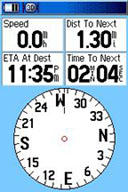 .......
.......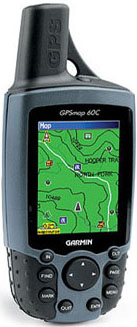 .......
.......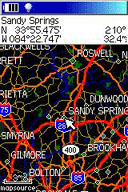
The GPSmap 60C has good Car Navigator features
without giving up Hiking capability.
Read two independant reviews of the GPSmap
60CSx (HERE)
and (HERE)
OVERVIEW:
The GPS-60C appears to us to be the new "GPS for all".
Street Prices are approximately $380, check discount prices (HERE).
The units do not come with maps, which are extra cost. Just as each
previous Garmin hand-held model has been an improvement over previous models,
the GPS 60C will have about every GPS feature available including auto-routing,
except for the voice prompts.
The 60 color and 76 color units also have the new
USB capability for uploading large maps. In a test of the new USB
speed, after building Index files, the Map Set, and eraseing the old files,
the USB upload time for 7.5MB of maps was 26 Sec. vs 800 Sec. for the Serial
upload. Thus the USB upload speed is roughtly 31 times faster than
the serial.
In the past, Garmin has "segmented" the GPS market into Outdoor,
Marine, Car Navigator, and Aviation. The 60C does a good job at Car
Navigation and Outdoor applications and a passable job with marine guidance.
This combination will fit a lot of people's needs.
This system has more different user screen options than any unit
that we have reviewed. See sample screens HERE.
A nice addition to the 60C is control of just WHICH of the many screens
are actually displayed. This is accessed through Menu, Menu, Page
Seq.
The G-60C has a sunlight-readable display with 256-color transreflective
TFT display. It is also the first color screen handheld we have seen
that offers a long battery life. Garmin's claims 30 hours on just
two AA alkaline cells seems to be about right for intermittent use without
a backlight. When we first looked at the screen of the G-60C indoors,
we felt the screen had to have the backlight on to be readable. BUT..
When we took it outside in even cloudy weather, we found the display
quite bright and readable without the backlight. This results from
Garmin's mew display technology. This product includes automatic
present-position-to-address feature routing
and WAAS in
a small handheld GPSR similar in size to the Garmin Rino units but with
a larger display (1.5" W x 2.2" H, 38 mm x 56 mm). With automatic
routing, users can input the address or waypoint of a destination
and the G-60C will compute a route and give turn-by-turn instructions as
the route is navigated. The GPS provides a moving cursor on
the moving map showing your position on the GPSR's internal map.
As a turn approaches, the map switches to a track-up display to aid in
the visualization of the needed turn. Two warnings are sounded prior
to the turn.
MAPPING SOFTWARE:
The G-60C DOES NOT come with any mapping software in the standard
package. Instead, it comes with a POI CD and software which allows upload
and download of waypoints, routes and tracks. It is designed to work
with "CitySelect 5" (NavTech-based maps), but it will also auto-route
with CityNavigator and MetroGuide-4 maps.
MG5 uses NavTech maps but will not autoroute on the G-60C, but will
on the PC. The user can download routes and waypoints from the PC
to the G-60C for routing use. CitySelect software is similar
to "CityNavigator" software furnished with the StreetPilot 2610 units.
CitySelect has the same excellent (but not perfect) maps, but routing
information has been slightly modified for the non-voice G-60C and similar
models. Using the optional (extra cost) CitySelect 5 maps,
a user can install ALL (or just some) USA regions and available Canada
maps into a PC computer. Then the user selects which map subsections
to load to fill all or part of the G-60C's 56 megabytes of map memory.
Garmin recommends the MapSource CitySelect maps for this product.
This review is based on the use of CityNavigator maps and not CitySelect
maps because CN5 maps were what we had handy. Results (should) be
identical for the two map systems. Garmin recommends their 24K Topo
product for use in OffRoad activities.
MapSource MetroGuide maps do not support autorouting within the new
60C; this is valid for Metroguide Europe and most others. Even worse, the
result of the PC autorouting cannot be transferred to the 60C. All intermediate
route points are ignored. So you should take care to buy the correct Mapsource
product for autorouting.
The MetroGuide USA maps (see
MG
USA FAQ for more information) will also auto-route on
the 60C, although Garmin says "they don't support them". HOWEVER,
the latest MG5 maps DO NOT have autoroute capability. In some
rural areas, these maps have more streets than the more expensive
CitySelect and CityNavigator maps. See HERE
for a comparison.
USING TRACBACK:
First record a track (turn Track Log, ON). You should then
'Save' it for future reference, or you can use the detailed track to TrackBack
along.
If you use the compass screen for guidance, you should select the
Course Pointer for better guidance information. You can also us the
Highway Page for a 3-D graphic of the trackback route.
From the Tracks menu, select either the current recorded track or
a saved track, and then press TracBack. The screen that comes up
is going to ask you which point on the track you want to TracBack to.
You can select this point with the cursor. (Each track will also
have a BEGIN or END waypoint you can select).
TIDE TABLES: (Thanks
to Mike)
Although Garmin doesn't include the 60C in their list of recommended
units to display Tide Tables, and may void the warranty, but the 60C apparently
can display them. They are available (HERE)
as a 5.13 MB download. As long as you have MapSource installed, you
can install this software and it will get added to your list of available
map products in MapSource as "GPSMAP 162/168 Tide Points". The next
step is to upload the Tide Points. This is just like any other map upload
from MapSource. Select the map sets and maps you want, including
the Tide Points you want, and proceed with the upload.
Once you have done this, your "Find" page will have an option for
"Marine". Select it and you will see an icon for "Tide Station" in
there. It works great on the 60C; I'm not sure why they only present
it for the 162 and 168. There are 3 "maps" for a total of 161 KB.
MEMORY:
Memory is not expandable. The G-60C will NOT accept memory
cartridges. In the state of Georgia, 56 megs will hold 100% of Georgia
plus small bits of Fl., SC, Tn, and Al. The "map chunks" loaded do
NOT need to be contiguous. Note: The G-60C contains
a base map which contains all of the major federal and state highways of
the USA and Canada. The G-60C can perform automatic routing on the
basemap as well as using either CS5/CN5 or MG4 USA maps for this purpose.
Thus, the user can load detailed maps for (say) Atlanta and Denver.
Then have G-60C generate a route to an address in Denver from Atlanta.
The G-60C will use the CS (or MG USA) map at the beginning and end of the
route and the base map along the way. This eliminates the need to
load CS (or other detailed) maps for the highway portions of most journeys.
BASEMAP:
The basemap in the G-60C comes in multiple versions depending
on the part of the world the G-60C is sold into. The base map CANNOT
be changed and so if you (for instance) buy a USA unit and use it in Europe,
you will have to load CitySelect maps into the G-60C for all areas you
intend to navigate as the USA version basemap has little detail for any
part of the world except the USA and Canada.
NOTES: This review is based
on G-60C firmware version 3.00, and current version number can be
seen by holding ENTER while turning the unit ON. This also
gives the diagnostics page. Press PAGE multiple times brings up additional
diagnostic screens. ON+PAGE clears the almanac, and ON+MENU is an erase
of stored GPS calibration and waypoint information!
AUTOMATIC ROUTE GENERATION
The G-76C has the ability to generate an AUTOMATIC route from your
current location to another point. The destination point can be any
of: an address, waypoint, road intersection, city or
town, highway exit, Point of Interest from the internal list,
or Recently Found Places. This extremely flexible system is
easy to operate and works quite well. We see generally high
quality routes generated with some that are "adequate" but not the ones
we would have chosen, but the performance we see is on a par with
the best current model auto navigators we have tested.
The current routing systems available cannot know traffic conditions
or detailed road conditions and so they will not always be able to take
local conditions into account when generating a route. When using CitySelect
or CityNavigator, the routes are almost always in the "excellent"
or "very good" class. (Note: By "very good", We
mean: The route was (almost) as good as the one we would have chosen,
or the route was efficient, direct, and without problems,
but was not exactly the route one would have chosen for themselves being
familiar with the area.)
HOW DOES THE USER INPUT A ROUTE REQUEST
TO THE G-60C?
It is pretty easy, but pictures help. Click
HERE Note: In addition to Addresses, you
can route to POI, Intersections, Waypoints, Cities, Expressway
Exits and Recently found places.
MANUAL ROUTE GENERATION:
Garmin supplied this solution: Put the unit in simulator mode
and then on that same satellite page press the menu button again and scroll
down to new location and press enter. Then choose the option of use map
and press enter on it. The next thing you will do is to move the pointer
on the screen with your rocker pad to where you want the unit to think
is your current location or starting point. Then press the find button
on your unit and enter the destination you wish to route to. The
unit will create a route from that starting point to the destination you
set it to. One can then use Automatic Route Recalculation ON or OFF
to get the desired routing instructions.
It is also possible to manually generate a route by going to the
route page and panning the pointer and setting a series of waypoints along
your intended route. Routes can also be generated from within
MapSource and uploaded to the unit.
WAYPOINTS: 1000 with name and graphic symbol, automatic display
of 10 nearest and with 10 proximity waypoints. The closest 50 waypoints
can be listed.
TRACKLOGS: The tracklog capacity is 10,000 trackpoints with
20 saved compressed tracks with 500 points each which allows a user to
retrace their steps.
ROUTES: 50 reversible routes with up to 250 points in each route
plus MOB and TrackBack modes.
Tracklog resolution can be set to Auto, Time or Distance. With
WAAS, this unit is well suited for placing or recovery of Geocached objects.
It has no trouble, with a few minutes averaging in the clear, to
establish a reference point within 3 meters.
GEOCACHE:
The manual isn't as clear as it could be for finding caches.
For optimum use (and to call up the compass page, as the manual shows)
if one in: Setup, Routing, sets Guidance Method and Follow Road Method
to "Prompted", then when accessing a Geocache waypoint, you can select
Off Road, and the compass page will appear. Also the waypoint selected
must be a geocache waypoint.
ACCURACY:
Using the same moderate tree-cover site as tests with the Garmin
GPS map 76S, we ran the same 30-minute test runs with
SA Watch comparing the G-60C to the Magellan SporTrak Color.
We also compared the accuracy of the units over an accurately known benchmark
(which is in the clear) using Waypoint Averaging. See plots and data
(HERE).
SCREEN RESOLUTION COMPARISONS:
 ......
......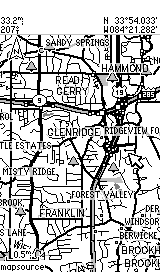 ......
......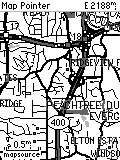 ......
......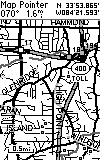
G-60C Screen
GPS-V screen
eMap Screen
G-III+ Screen
160x240
160x256
120x160
100x160
In actuality, all four screens are just about the same physical
size.
Note: Above pictures are NOT to scale
but show the different screen resolutions and presentation methods of the
three models. The actual size of the G-60C screen is 1.5 x 2.2 inches
and the GPS-V screen is approximately 1.5"x 2.2" which is same as the G-III+.
ALL of the screens are about the same physical size, but our pictures from
different times using different screen dump programs fail to show this.
Resolution suffers when we tried to make them all the same size as we no
longer have the original images to work with.
HOW GOOD ARE THE Garmin MetroGuide CitySelect
5 and CityNavigator 5 MAPS?
One of the first thing you'll notice when looking at the maps
is the higher resolution screen of the G-60C and the GPS-V compared
with the G-III+ and others. The CitySelect 5 and CityNavigator 5
and MetroGuide 5 maps are substantial improvements over earlier maps,
but you will still find errors and omissions in some areas.
There are even a few rural areas where the old Metroguide 4 maps have more
detail and accuracy. Overall we rate the CS/CN
(NavTech Source) maps excellent and MG4 USA we rate as "very good".
We found that the CS5/CN5 map/data system regularly generates better routes
(more like what you would do) than the MG4 USA. However, in
cases where you do not want to "blindly follow the directions", you
can deviate on your own selected path and the G-60C will automatically
recalculate the route. In our experiences, all three map systems
would get you to your destination. A very few times, we did
notice MG4 USA takes some strange detours, but these were rare.
The G-60C Receiver
The new G-60C appears to have an improved receiver. In tests,
it was generally able to pick up just as many and sometimes more than a
GPS-76 that we compared it with. (Don't read too
much into this as sample to sample variations do occur.) All GPS-V
cable accessories work with the G-60C. The G-60C has been enhanced
with additional user map memory (total=56megabytes), WAAS operability,
a high definition daylight viewable color screen, perpetual calendar,
fish/hunt predictor. It also includes six electronic games
for when you get bored with GPS Unlike the GPS-V, there is no
gas mileage calculator feature. The G-60C has an alarm BEEPER used
for alarms (8 selectable tones), messages and turn warnings. All
of the added memory in the G-60C is internal as opposed to a removable
cartridge. Unique in the Garmin line at this time, the
G-60C comes with both a USB jack and an older style round GPS-V serial
cable jack.
The G-76C receiver comes with (only) a USB DATA cable for loading
maps and updated firmware. The older serial port type cable is NOT
included. You will need the serial type cable if you want to provide
external power to the unit or use its NMEA serial output. However,
you CAN use the USB cable to provide real-time tracking to any MapSource
map while using the NMEA, Garmin, or Text outputs.
There are new menus in the G-60C to support the many new features, but
those familiar with the GPS-V, StreetPilot and other Garmin units
will be right at home with the operation of the G-60C. With the G-60C
you can do the usual route/waypoint/track management,
(including TrackBack and MARK) plus, the automatic address-to-address
routing capability can operate to design routes INSIDE the G-60C itself.
Pressing ON plus MENU will erase all of the user data. The GPS-60C
uses FLASH memory for long term storage and thus has NO backup battery
which in the past has been prone to failure.
SOFTWARE COMPATIBILITY:
As
with many other Garmin models,
G7ToWin Version A.00.174 has been updated to support up/downloading
of waypoints, tracks, and routes to the Garmin 60C, through both the USB
and Serial cables. Also screen captures can be downloaded with either USB
or Serial.
The
following programs are known only to be compatible with the G60C's serial
connection:
Ozi
Explorer is compatible for up/download waypoints, tracks, and
routes to the Garmin 60C.
GARtrip
is compatible with the serial cable, and USB will follow with a future
program release.
GPS Utility
provides Ver. 4.15.3 (available from the download page) which supports
the GPS 60C over the USB interface.
EasyGPS and ExpertGPS
will support all Garmin USB receivers in their next releases.
Street
Atlas 4 thru 9 can upload waypoints and routes, download tracks, but cannot
download waypoints or routes from the unit. It's not known if Street Street
Atlas 2004 can calculate routes, create waypoints, and upload these to
the G-60C.
OTHER FEATURES:
Other new features in the G-60C include a "pop
up" direction screen showing a blown up picture of the coming intersection
with an arrow pointing the way to turn and a couple of BEEPS at different
distances from the intersection to warn you of the upcoming turn.
Proximity waypoints are also supported with the beep alarm. The screen
backlight can be made quite bright. Probably among the brightest
we have seen. Running the backlight frequently or for long durations
will dramatically reduce battery life.
Our estimate of battery life in the Normal Mode for the G-60C with alkaline
batteries is approximately 27 hours (continuous) based on 70ma battery
draw and a 1900 mah typical AA alkaline battery life at 70ma. A "Battery
Saver" mode that provides a fix every five seconds as opposed to once per
second is supposed to increase battery life by about 30%; however, this
mode prevents using the WAAS corrections. We measured 68ma in both
the Normal and Battery Saver modes, because lock is required for the Battery
Saver mode feature to kick in. With the backlight set to brightest,
the unit draws 125 ma (about 14 hours of life). In the Indoor (no
GPS lock) mode, the unit draws only 40 ma and should run for 45 hours.
Garmin's SPECIFICATIONS for the G-60C can be found HERE.
FEATURES of the G-60C:
We are going to try something new in explaining the features of
the G-60C. The number of option screens is quite large and the some
features are somewhat obscure and difficult to find. Therefore,
we are going to show screen photos of most of the G-60C's operational screens
and this will (hopefully) give a feature overview without too many words.
For this screen detail and overview, click
HERE.
The "highway display" useful for marine applications is substituted
by the above pointer which can be changed from a Bearing pointer to a Course
pointer. "Bearing" is the direct direction to the next routepoint
from present position.
The Course pointer calculates a fixed line from present position
or a routepoint to the next routepoint. The "To Course" command directs
one immediately back to the course line. NOTE that the Bearing pointer
is not the direction of the course line which remains fixed. Also
note the TO/FROM flag which is present in an aircraft HSI.
HOW DOES THE G-60C DIFFER FROM THE GPS-V
(Ver. 2.50)?
Daylight viewing color screen with lower current backlighting for
night viewing.
A fixed Helix Antenna instead of movable, and only a vertically-oriented
screen.
Lower battery drain gives about 27 hours life on just 2 alkaline
AA batteries -more than the G-V with four batteries.
The G-60C has 8 selectable audio BEEP for alarms, messages,
and routing alerts.
The G-60C has a user programmable message for the initial Welcome
Screen.
The G-60C has both a USB and a Serial data cable connector.
Not all functions are available on both cables.
The G-60C is lighter than the GPS-V and weighs only 207 g with NiMH
batteries.
The G-60C has the usual automatic daylight savings time for the
US plus some "Other" selections for the world.
The G-60C has unique features for GeoCache users.
The G-60C has a quick disconnect belt hook assembly (which can be
removed by unscrewing).
The G-60C has 50 reversible routes, 10,000 track points with TracBack
and 1000 waypoints with many new graphical icons.
The G-60C has up to 56 megabytes of user map memory for detailed
road, topo or other maps instead of 19 MB.
The G-60C has six electronic games included for kids and adults
alike as compared to two in the G-V
The G-60C offers better BlueChart compatibility (including Tidal
Prediction).
CITY SELECT AND METROGUIDE USA
MAPPING PRODUCTS More Details:
The Garmin MapSource CitySelect5/CityNavigator5 maps are high
quality electronic maps using NavTech map data. NavTech has excellent
maps (the best GPS/Electronic maps we know of), and they now offer
complete USA coverage plus most of the populated areas of Canada.
European, Australian, and South African Maps are also available.
Note: For the purposes of discussion, CityNavigator and CitySelect
provide almost identical maps and performance. CN5 is designed for
the SP-III/26xx and CS is designed for the G-60C, iQue and the GPS-5.
Not nearly as complete as CityNavigator5 and CitySelect5, MG USA
does include an extensive listing of POIs including restaurants,
hospitals, post offices, lodging, entertainment,
shopping, emergency services, and transportation services but
these will not be as complete as CS5/CN5. We can say that "generally"
the POI data is accurately positioned on all these products, but
there are many restaurants, hotels, post offices, and
other POI that are conspicuous by their absence in our area and quite a
few are out of position. However, there are a large number
available and we do find the POI very useful. MetroGuide4 USA
road accuracy is judged "good" by Jack and Joe. CitySelect5
and CityNavigator5 we judge accuracy to be "good to excellent". MetroGuide
5 maps are better but do not offer autorouting in the GPS.
MetroGuide USA maps are more up to date than the older MetroGuide and R&R
maps. MapSource 4.03 (or later) includes the ability to track your
progress on your laptop computer when it is connected to your GPSR with
the data cable. Note: MapSource 4.03 and later is a free
update from the Garmin website for purchasers of ANY MapSource product.
MapSource MetroGuide USA will not run on MAC computers without an emulator
and many are not successful even with an emulator.
As of February 2004, NO software other than Garmin's MapSource
CDROM Maps can be uploaded into the G-60C. All consumer GPS vendors
have the same limitation for their respective units. This includes
Delorme Street Atlas 9, Microsoft Streets, and all other non-Garmin road
maps. Additional features of MapSource uploadable maps are
discussed below.
WHAT IS OUR OVERALL OPINION OF THE G-60C?
The G-60C is a superior product overall. It provides a complete
Car Navigator feature and Hiking GPS features as well as a useful set of
Marine navigation features. While it is not as inexpensive as the GPS-5
and some other competitors, we think the color screen is about the
best we have seen for out-in-the-sunshine use.
Other solutions such as the SP2610, SP-III, and
various handheld palm computer products (Magellan Companion and Raco Destinator
for example) offer larger (and optionally color) screens but the overall
feature mix in the G-60C is hard to beat for users looking for a "full
featured and general purpose" handheld GPS receiver. The G-60C is
a general purpose unit equally at home hiking or on the highway and useful
in casual marine applications. The "ON ROAD" option provides good
highway and road guidance with specialized screens. The "OFF ROAD"
mode provides the standard Garmin circular compass display that we like
for hiking and marine use and other G-60C features make the unit quite
suitable for hiking activities as well as on the highway use.
We found the battery life excellent and the longest we have seen
with a color screen and especially with just two AA alkaline batteries.
We liked the higher speed CPU which results in much faster screen redraws
and route recalculations as compared with the GPS-V.
We found the G-60C equally robust as compared with the GPS-V and it is
rated waterproof to IPX-7. The G-60C antenna is sturdy and the overall
construction appears robust and this unit should be as waterproof as any
other Garmin unit.
The GPS-60C does NOT have a rotateable screen like the GPS-V had
but we like the vertical screen in the car and when we are hiking better
anyway.
The GPS-60CS is essentially the same instrument as the G-60C but
with a barometer and electronic compass added. We have not tested
this configuration.
WHAT DO WE NOT LIKE ABOUT THE G-60C?
There is not a lot to complain about with the G-60C. It packs
a lot of functionality in a small package. But:
1) We wish the backlight setting did not go to zero automatically
when power is turned off.
2) We wish the G-60C had a map cartridge capability.
3) We wish the various "page names" stayed on each of the many pages
until the space was otherwise needed. The unit has so many different
pages we sometimes got confused at first as to what setup pages we were
looking at.
4) The G-60C has a very odd shape -something like a potato- and
is unstable when placed on the dash of a moving car.
For questions about the G-60C hardware or mapping software,
eMail
JOE
or
JACK
Return to Joe and Jack's
Main Website, Click HERE
 .......
....... .......
.......
 ......
...... ......
...... ......
......